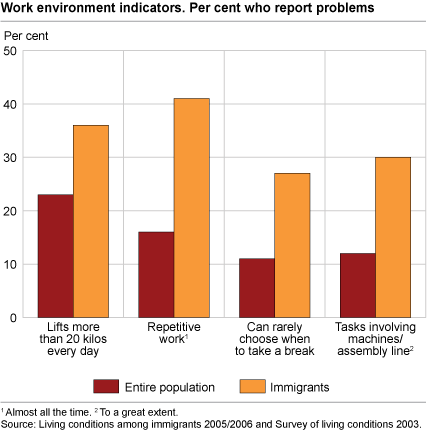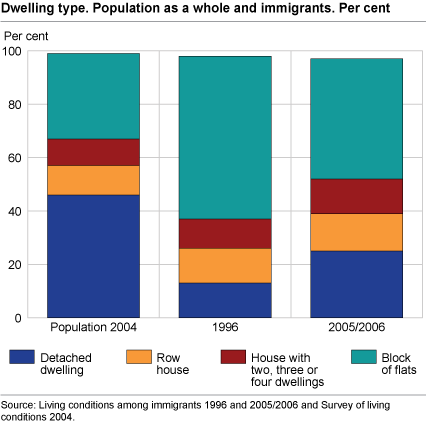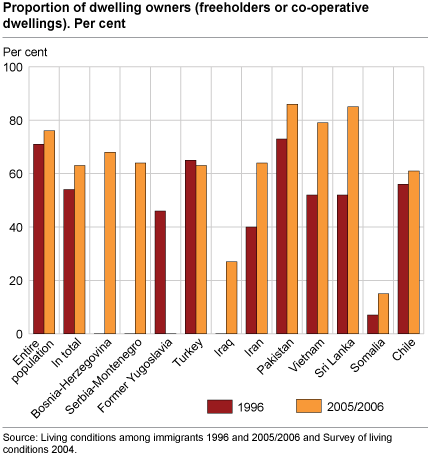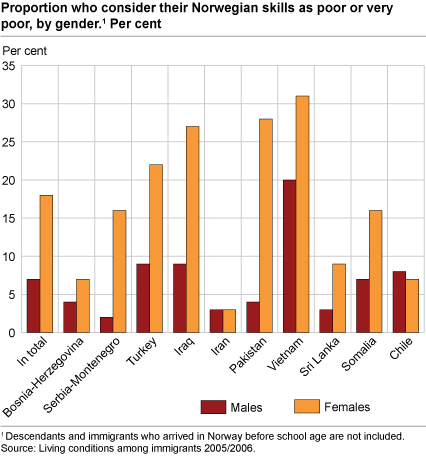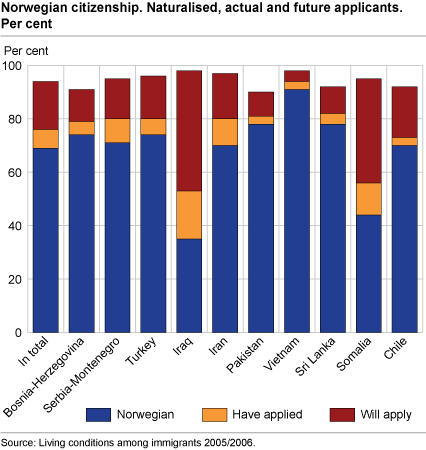Content
Published:
Improved housing for immigrants
The housing standards among immigrants have improved since 1996. More immigrants live in detached houses, and more immigrants own their home. These are some of the results of the most recent survey on living conditions among non-Western immigrants.
The report based on the survey describes the living conditions of one half of the non-Western immigrant population in Norway. The subjects covered range from housing and work environment to education level, family and friends, media habits and perceived discrimination.
One in four study in Norway
Among the immigrants who came to Norway at the age of 18 or over, almost two out of ten had not completed any education, while one out of four had higher education. The education level is highest among immigrants from Iran, Chile and Bosnia-Herzegovina and lowest among Turkish and Somali immigrants.
More likely to experience problems at work
The proportion of employed was 57 per cent among immigrants, compared with 75 per cent in the population as a whole. Furthermore, 11 per cent of the immigrant population were temporarily employed, compared with 23 per cent in the population as a whole. Immigrants are over-represented in jobs with no education requirements and under-represented at managerial level or in jobs that require higher education. Immigrants had more problems with their ergonomic work environment than others, and more immigrants perceive their work as mentally taxing.
Lowest income among Somalis and Iraqis
Immigrants’ net household income is markedly lower than the average in the population as a whole. Immigrants from Bosnia-Herzegovina and Sri Lanka have the highest incomes, while immigrants from Somalia and Iraq have the lowest incomes. In addition, immigrant households are larger, which means that more people share the household income compared with the average Norwegian household.
Send money to family members back home
More than half of the immigrants and descendants interviewed say that they help family members in their country of origin financially. One in ten own land in their country of origin, while a slightly larger share own a dwelling. One in four thinks they will return to their home country, but not until they reach old age.
More immigrants own their dwelling
The share of immigrants who live in detached houses and the share who live in owned dwellings have increased. Fewer live in rented accommodation and it is less common to live in cramped conditions than ten years ago. However, immigrant families still have poorer housing standards than average.
Religiously active
Immigrants and their descendants are more religiously active than the average Norwegian. They attend more religious gatherings and prayers, and religion is more important to them. Two out of three immigrants are brought up as Muslims. Many Chilean and Iranian immigrants say they no longer belong to the faith in which they were brought up.
Poor Norwegian skills among female immigrants
Among immigrants who came to Norway at the age of six or over, more than twice as many women as men consider their Norwegian skills as poor. The gender difference is particularly pronounced among immigrants from Pakistan, Iraq and Serbia and Montenegro. The correlation between Norwegian skills and employment is strong.
Violence and theft
Immigrants do not encounter more problems with theft, harm, violence or threats than the average Norwegian. Only 9 per cent of all immigrants have been the victim of theft and/or harm, compared to 17 per cent in the population as a whole.
Majority would like Norwegian citizenship
Two out of three immigrants in the survey are Norwegian citizens. If we include those who had applied or were planning to apply for Norwegian citizenship at the time of the survey, the share increases to 94 per cent. Around half of the remaining respondents would apply for Norwegian citizenship if they were guaranteed to keep their original citizenship. The main reason for applying for Norwegian citizenship is access to full rights and obligations.
Men experience most discrimination
Half of the immigrants in the sample have experienced discrimination in one or more areas. Immigrants from Somalia and Iran are most subject to discrimination. Men had experienced more discrimination than women, probably because they participate in more areas of society than women.
For more information, see Living Conditions Among Immigrants in Norway 2005/2006 .
Ten large non-Western immigrant groups are interviewed about their living conditions. The sample consists of 3 000 persons with at least two years of residence in Norway. They come from Bosnia-Herzegovina, Serbia and Montenegro, Turkey, Iraq, Iran, Pakistan, Sri Lanka, Vietnam, Somalia and Chile. The immigrant population from these countries made up 145 000 persons at the beginning of 2006, half of the non-Western immigrant population living in Norway. |
Tables:
- Table 1 Highest education completed in Norway or abroad, by country of origin and year. Per cent
- Table 2 Persons employed at least one hour last week, by country of origin and year. Per cent
- Table 3 Own land in the country of origin, alone or together with someone, by country of origin. Per cent
- Table 4 Own dwelling abroad, alone or together with someone, by country of origin. Per cent
- Table 5 Provide financial support to family in the country of origin and how often, by country of origin. Per cent
- Table 6 Plan to move to the country of origin, by country of origin. Per cent
- Table 7 Proportion having experienced discrimination in different areas, by country of origin. Per cent
Contact
-
Statistics Norway's Information Centre
E-mail: informasjon@ssb.no
tel.: (+47) 21 09 46 42


